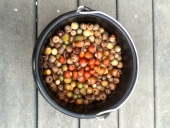posted 9 years ago
I agree its hard to ascertain every scenario from the original posts limited information, but it looks like significant acreage to me to justify a laneway. I made the assumption that the lines depicted were straight and situated close to where he wanted, but would most likely be tucked up against the ditch of the drive just to ensure land efficiency in reality.
But I think it would be in the best interest of Reid to still have the laneway. He mentions horses which require significantly more care then the other livestock of choice, and most likely would be grazed in a different paddock then the others. Let's say he wanted to go for an evening horseback ride, or bring his horses in for nightly grooming; grabbing his horse on pasture with it grazing among other livestock, or being lead through other paddocks with other livestock; that would be a nightmare at the gate. I am not so sure about goats and pigs because I have never had them, but I know with sheep, you might get away with it the first day, but after that you would have 100 sheep following you to the gate and packed around it tight just waiting for it to be opened. Now that is a conundrum, and trust me I have been there more than once.
My laneway is 12 feet wide for a reason, I like to be able to drive a tractor down it if I have to and 12 foot gates are easy on the checkbook. However, it could be narrower. Still at an ample 12 feet wide, you would have to have a laneway 3/4 of a mile long before it took up a single acre of space. I have no idea how big the field in question is, it looks around 3 acres to me, but that is only a guess. If that holds true, then a laneway even as wide as mine would only occupy less than 1/3 of an acre (15,000 square feet).
On my farm, my ancestors built laneways too and it was not because son 1, 2 and 3 had nothing to do but pile up rocks in long rock walls 10 feet apart, they considered them a nessesity. Considering this was done in 1830-1850, pasturing animals has not changed, and so out of experience, I believe laneways are just as vital today. In this picture, just too the left of the main rock wall, you can see the second rockwall showing the laneway that existed many years ago despite having grown back up into forest. We are looking at a laneway!
DSCN0029.JPG
![Filename: DSCN0029.JPG
Description: [Thumbnail for DSCN0029.JPG]](/t/57934/a/42381/thumb-DSCN0029.JPG)









![Filename: Zones.png
Description: [Thumbnail for Zones.png]](/t/57934/a/42101/Zones.png)




























 1
1















